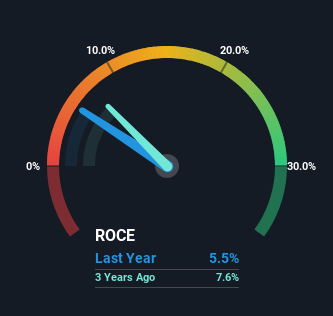Here's What To Make Of Sinofert Holdings' (HKG:297) Decelerating Rates Of Return
There are a few key trends to look for if we want to identify the next multi-bagger. Ideally, a business will show two trends; firstly a growing return on capital employed (ROCE) and secondly, an increasing amount of capital employed. Put simply, these types of businesses are compounding machines, meaning they are continually reinvesting their earnings at ever-higher rates of return. Although, when we looked at Sinofert Holdings (HKG:297), it didn't seem to tick all of these boxes.
Understanding Return On Capital Employed (ROCE)
If you haven't worked with ROCE before, it measures the 'return' (pre-tax profit) a company generates from capital employed in its business. To calculate this metric for Sinofert Holdings, this is the formula:
Return on Capital Employed = Earnings Before Interest and Tax (EBIT) ÷ (Total Assets - Current Liabilities)
0.055 = CN¥661m ÷ (CN¥20b - CN¥8.0b) (Based on the trailing twelve months to June 2024).
So, Sinofert Holdings has an ROCE of 5.5%. Even though it's in line with the industry average of 6.0%, it's still a low return by itself.
Check out our latest analysis for Sinofert Holdings

In the above chart we have measured Sinofert Holdings' prior ROCE against its prior performance, but the future is arguably more important. If you're interested, you can view the analysts predictions in our free analyst report for Sinofert Holdings .
What Does the ROCE Trend For Sinofert Holdings Tell Us?
In terms of Sinofert Holdings' historical ROCE trend, it doesn't exactly demand attention. The company has consistently earned 5.5% for the last five years, and the capital employed within the business has risen 51% in that time. Given the company has increased the amount of capital employed, it appears the investments that have been made simply don't provide a high return on capital.
One more thing to note, even though ROCE has remained relatively flat over the last five years, the reduction in current liabilities to 40% of total assets, is good to see from a business owner's perspective. Effectively suppliers now fund less of the business, which can lower some elements of risk. Although because current liabilities are still 40%, some of that risk is still prevalent.
The Key Takeaway
As we've seen above, Sinofert Holdings' returns on capital haven't increased but it is reinvesting in the business. Although the market must be expecting these trends to improve because the stock has gained 56% over the last five years. However, unless these underlying trends turn more positive, we wouldn't get our hopes up too high.
One more thing, we've spotted 2 warning signs facing Sinofert Holdings that you might find interesting.
While Sinofert Holdings isn't earning the highest return, check out this free list of companies that are earning high returns on equity with solid balance sheets.
New: Manage All Your Stock Portfolios in One Place
We've created the ultimate portfolio companion for stock investors, and it's free.
• Connect an unlimited number of Portfolios and see your total in one currency
• Be alerted to new Warning Signs or Risks via email or mobile
• Track the Fair Value of your stocks
Have feedback on this article? Concerned about the content? Get in touch with us directly. Alternatively, email editorial-team (at) simplywallst.com.
This article by Simply Wall St is general in nature. We provide commentary based on historical data and analyst forecasts only using an unbiased methodology and our articles are not intended to be financial advice. It does not constitute a recommendation to buy or sell any stock, and does not take account of your objectives, or your financial situation. We aim to bring you long-term focused analysis driven by fundamental data. Note that our analysis may not factor in the latest price-sensitive company announcements or qualitative material. Simply Wall St has no position in any stocks mentioned.
About SEHK:297
Sinofert Holdings
An investment holding company, engages in the production, import and export, distribution, and retail of fertilizer raw materials and crop nutrition products in Mainland China and internationally.
Undervalued with solid track record.
Market Insights
Community Narratives


Recently Updated Narratives


Engineered for Stability. Positioned for Growth.


MINISO's fair value is projected at 26.69 with an anticipated PE ratio shift of 20x


Fiverr International will transform the freelance industry with AI-powered growth
Popular Narratives


MicroVision will explode future revenue by 380.37% with a vision towards success


NVDA: Expanding AI Demand Will Drive Major Data Center Investments Through 2026



